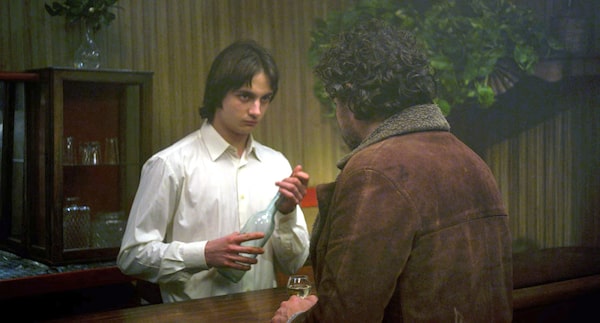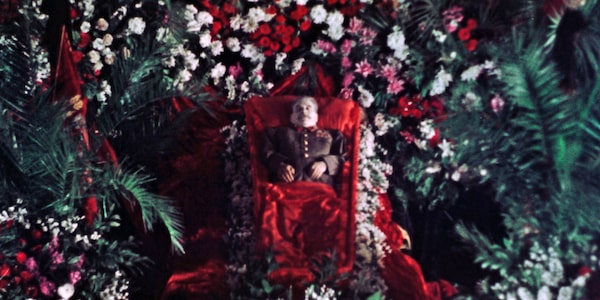
In Heimat is a Space in Time, German director Thomas Heise reads wartime family letters between an increasingly desperate Jewish family trapped in Vienna, and their daughter and her Gentile husband living in Berlin.Courtesy of TIFF
In a marathon of family memoirs that will be showing at the Toronto International Film Festival, the German director Thomas Heise treats video and audio as separate, if complementary, strands. So, we watch contemporary footage of the Berlin subway – two scavengers walk by pushing carts stuffed with bottles; young lovers bid farewell for the evening – and we listen to letters from the 1920s about the hyper-inflation in Weimar Germany and a blossoming romance between the correspondents. Almost four hours in length, Heimat is a Space in Time is an exceptional record of the persistence of history and memory in the current moment.
In that regard, it is not alone at TIFF: The festival’s Wavelengths program always offers the most daring and demanding films of the year, and the 2019 selection seems particularly given to tough films that draw on the past to reflect the present.
TIFF 2019: Updated – The Globe’s latest ratings and reviews of movies screening at the festival
In the most acute example in Heimat, Heise reads wartime family letters between an increasingly desperate Jewish family trapped in Vienna, and their daughter and her Gentile husband living in Berlin. Meanwhile, the camera slowly pans down an official Nazi list of Vienna’s Jewish citizens. The effect is both visceral – because you know what is coming – and intellectual: Noting the gap between officialdom’s dehumanization of a supposedly troublesome group, and the individuals’ experiences of fear and passion, the viewer may begin to think about current U.S. government attitudes toward asylum seekers and the trauma of real children separated from their parents and kept in pens.
Similarly, the Spanish film Endless Night by the Galician director Eloy Enciso makes viewers consider what enabled a fascist dictatorship to rule Spain for almost four decades by depicting the diverse attitudes of common people both supportive of and opposed to the regime. Inevitably, the question arises: Could it happen again, whether in Spain or elsewhere?

The Spanish film Endless Night by the Galician director Eloy Enciso makes viewers consider what enabled a fascist dictatorship to rule Spain for almost four decades by depicting the diverse attitudes of common people both supportive of and opposed to the regime.Courtesy of TIFF
“I do think that Longa Noite [Endless Night] has strong contemporary resonance, especially in its dialogue about fear; the basic struggle for some to survive is just as urgent today as it was under the Franco regime,” Wavelengths programmer Andréa Picard observed in a recent e-mail exchange. “While those dialogues are from a particular moment in time, I found them to be just as relevant today.”
Those dialogues, by the way, are all found texts: Enciso has assembled his episodic script – in which a former Republican fighter attempts to return home to postwar Spain – from plays, diaries and letters. In a film in which every shot is perfectly composed, dramatically lit and intensely focused, non-professional actors deliver monologues or dialogues about their current attitudes to the regime or their civil war experience, while Anxo (Misha Bies Golas) moves toward his fateful encounter with its enduring power.
Interestingly, both Endless Night and Heimat, based on a remarkable stash of family letters and diaries, use existing texts rather than fashioning new scripts. In Heimat, Heise declines the tidy storytelling of the traditional documentary, simply offering what he has and leaving the viewer to fill in the gaps: “The material used in this film is what remains of my family,” he says in his director’s notes. In Endless Night, Enciso does the same for the drama, creating a fractured, episodic fiction from real historical texts.

In Vitalina Varela, director Pedro Costa's heroine arrives from Cape Verde just a few days after the death of the husband she has been waiting 40 years to join, only to discover he was living in criminality and squalor.Courtesy of TIFF
The two titles represent the fusion of documentary and fiction that has happened at the cutting edge of film, to the point where Picard feels the term hybridization is now passé.
“You are seeing a total merging of documentary and fiction. People are differentiating less and less,” she said.
This can create some remarkable cinematic experiences that are difficult to categorize. For years, the Portuguese director Pedro Costa has recreated in his films the dark alleyways and concrete bunkers of Fontainhas, a lost slum on the outskirts of Lisbon once inhabited by the poor, the criminal and the marginalized, including many immigrants from Portugal’s former African colony of Cape Verde. In his latest film, Vitalina Varela, his heroine arrives from Cape Verde just a few days after the death of the husband she has been waiting 40 years to join, only to discover he was living in criminality and squalor. Slow, quiet and dark – literally; all the scenes take place at night or in windowless interiors – the elliptical film immerses the viewer both in Fontainhas and in Vitalina’s grief. The notable thing is that the story is true; the real Vitalina Varela, who won the best actress prize at the recent Locarno film festival, is playing a version of herself.

State Funeral is Sergei Loznitsa’s third film using archival Soviet footage to expose the propaganda of the murderous Stalinist regime.Courtesy of TIFF
State Funeral is another example of this boundary-breaking, in this instance turning fake news into real politics: It is Sergei Loznitsa’s third film using archival Soviet footage to expose the propaganda of the murderous Stalinist regime. In last year’s The Trial, he turned hours of footage from a government show trial into a chilling melodrama. Now, with State Funeral, he uses two hours’ footage of the heavily orchestrated national mourning surrounding Stalin’s death in 1953 to undercut itself. Often, the scenes, of ethnic minorities in traditional dress gathering to bow their heads or factory workers watching as the leader’s portrait rises above the jobsite on a crane, are laughable, but more often the mass demonstrations feel horribly tragic in retrospect. As current events scream the message from the rooftops, these films bring subtle humanist tones to the same serious warning: Don’t forget history.
 Kate Taylor
Kate Taylor